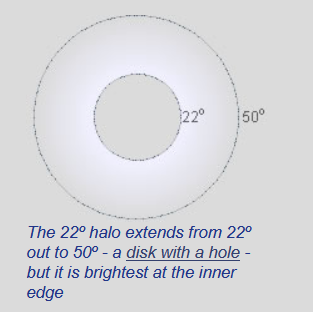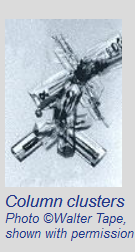22º Halo Formation
The Formation of the 22º Halo: A Phenomenon in Atmospheric Optics
Atmospheric optics is a fascinating field that explores the various optical phenomena that occur in our atmosphere. One such phenomenon is the formation of the 22º halo, a circular halo of light that appears around the sun or moon. In this article, we will delve deeper into the intricacies of this captivating optical display and shed light on some lesser-known aspects.
The Deflection of Rays
When light passes through a poorly aligned hexagonal prism crystal, it is deflected through various angles. This deflection occurs due to the refraction of light at each face of the crystal. The minimum deflection for red light, which contributes to the bright inner region of the halo, is approximately 21.7º. Interestingly, when the crystal is rocked back and forth around this position, multiple rotational positions produce deflections close to this minimum. These rays collectively contribute to the halo's luminous inner edge.
Minimum Deviation Effect
The majority of rays passing through the prism are deflected at angles near 22º, forming the bright inner edge of the 22º halo. This phenomenon is known as the "minimum deviation" effect and is commonly observed in halo and rainbow formation. Minimum deviation rays are symmetrical, entering and leaving the crystal at the same angle, with the ray crossing inside the crystal being parallel to a prism face. Rays deviated more strongly produce the outer halo light, which gradually fades away as the angular distance from the sun increases.
The Dark Area Inside the Halo
Inside the 22º halo, there is a distinct absence of light, creating what is often referred to as a "hole in the sky." This absence of refracted light occurs because no light is refracted through smaller angles than 22º. As a result, this area appears dark compared to the surrounding halo.
The Origin of Colors
The colors observed within the 22º halo are a result of differential refraction of light. Red light, being refracted less strongly than other colors, forms the inner edge of the halo and exhibits a reddish hue. Moving away from the inner edge, the colors transition through shades of orange and yellow before eventually blending into blue. However, the colors other than red tend to overlap, leading to indistinct and washed-out hues.
Uncertainty Surrounding Crystal Shapes
Determining the exact crystal shapes responsible for the formation of the 22º halo remains a challenge. As crystals descend in clouds, drag forces attempt to align them, making it difficult to explain how ordinary plates or long columns could be so poorly oriented as to form this halo. While intermediate length equidimensional prisms could potentially be poorly oriented, they are not commonly found in large numbers during halo displays. Some researchers suggest that large imperfect columns and clusters of columns may be responsible for most 22º halos, but the crystals responsible for the finest and most colorful halos are still not definitively known.
Ray Splitting and Transmission
When light passes through an ice crystal, it undergoes a process of ray splitting and transmission. At each surface of the crystal, a ray splits into partially reflected and partially refracted rays. The angle of incidence determines the exact split between these components. The width of the beam that can pass through the crystal is greatest at the angle of minimum deviation, contributing to the concentration of rays in this region. Additionally, the rate of change of deflection with prism rotation is smallest at the minimum deviation angle.
The formation of the 22º halo is a complex and captivating phenomenon that showcases the intricate interplay between light and atmospheric conditions. While many aspects of this optical display have been elucidated, there are still mysteries surrounding the exact crystal shapes involved. Continued research and observation will undoubtedly shed further light on this mesmerizing atmospheric optics phenomenon.

22º halo ray path through a poorly aligned hexagonal prism crystal. Rays pass through faces inclined at 60° to each other. The poor orientations form the circular halo.
Rays are deflected through many different angles. Mouse over the slider to see how the refraction changes as the crystal rotates ..
Find the minimum deflection of 21.7º for red light. This occurs when the refraction at each face is the same and the inner ray is parallel to the intermediate crystal face.
Rock the crystal back and forth around this position ~ notice how many rotational positions produce deflections close to the minimum. These rays all contribute to the halo's bright inner region.
Ray deflections
Rays passing through two prism side faces inclined 60° to each other are deflected through angles from 22° up to 50°.
Minimum deviation Most rays are deflected through angles near to 22° to form the bright inner edge of the halo.
This is a common "minimum deviation" effect which operates in halo and rainbow formation. Rays cluster together near to the angle where they are deviated least... Minimum deviation rays are symmetrical, they enter and leave the crystal at the same angle and the ray crossing inside the crystal is parallel to a prism face.
Rays deviated more strongly produce the outer halo light which fades away with increasing angular distance from the sun until it is undetectable.

No light inside 22º
No light is refracted through smaller angles and so the area inside the halo is dark - a 'hole in the sky'. †
Origin of colours
Red light is refracted less strongly than other colours and so the halo's inner edge is red hued sometimes tapering away through oranges and yellows to blue. All but red are indistinct and washed out because they overlap considerably.
Crystal shapes
The actual crystal shapes responsible for the halo are uncertain. As crystals drift downwards in clouds the drag forces tending to align them are strong. It is difficult to explain how ordinary plates or long columns could be so poorly oriented to be able to form this halo.
Intermediate length equidimensional prisms would more likely be poorly oriented but they are not very common. They are not found in any great numbers when crystals are sampled during halo displays.
Large imperfect columns and/or clusters of columns might produce most everyday 22° halos, suggests Walter Tape‡. However, the crystals responsible for the finest and most colourful 22° halos are still not positively known. The most common of the halos is perhaps the least understood!
Photo ©Walter Tape,
shown with permission

.
The diagram is accurately computed for rays of 650nm wavelength (red) and 400 nm (purple) passing through an ice crystal.
At each surface a ray splits into partially reflected and partially refracted rays. The exact split depends on the angle of incidence. For clarity the diagram shows only the components contributing to the 22º halo.
.. There are other factors. The fraction of the ray transmitted depends on the angle of incidence. The width the beam which can pass through the crystal is also greatest at the angle of minimum deviation. However, the largest effect is that the rate of change of deflection with prism rotation is smallest at the minimum deviation angle - thus more rays concentrate there.
† Some rays pass undeflected through opposite faces of the prism but they are, of course, indistinguishable from the sun's glare.
‡ See "Atmospheric Halos" by Walter Tape.
Note: this article has been automatically converted from the old site and may not appear as intended. You can find the original article here.
Reference Atmospheric Optics
If you use any of the definitions, information, or data presented on Atmospheric Optics, please copy the link or reference below to properly credit us as the reference source. Thank you!
-
<a href="https://atoptics.co.uk/blog/22-halo-formation/">22º Halo Formation</a>
-
"22º Halo Formation". Atmospheric Optics. Accessed on April 27, 2024. https://atoptics.co.uk/blog/22-halo-formation/.
-
"22º Halo Formation". Atmospheric Optics, https://atoptics.co.uk/blog/22-halo-formation/. Accessed 27 April, 2024
-
22º Halo Formation. Atmospheric Optics. Retrieved from https://atoptics.co.uk/blog/22-halo-formation/.